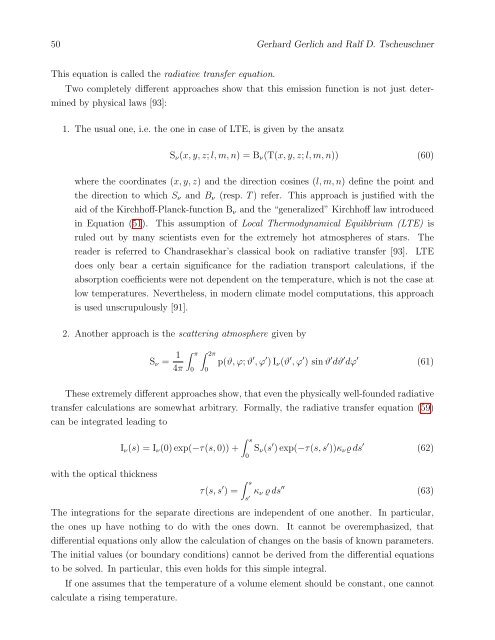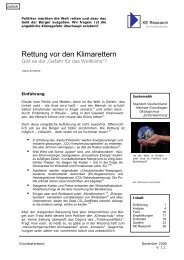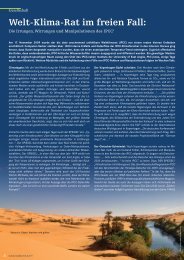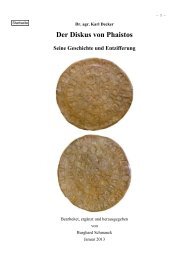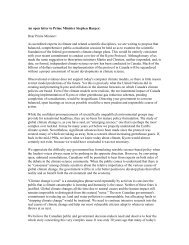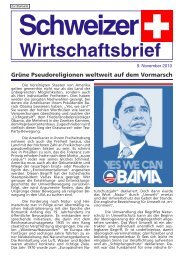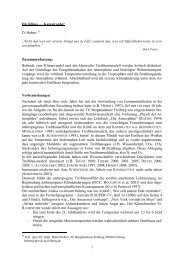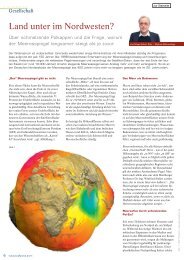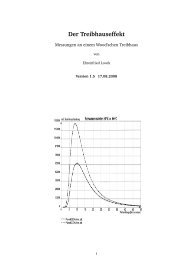Falsification Of The Atmospheric CO2 Greenhouse Effects Within ...
Falsification Of The Atmospheric CO2 Greenhouse Effects Within ...
Falsification Of The Atmospheric CO2 Greenhouse Effects Within ...
Create successful ePaper yourself
Turn your PDF publications into a flip-book with our unique Google optimized e-Paper software.
50 Gerhard Gerlich and Ralf D. Tscheuschner<br />
This equation is called the radiative transfer equation.<br />
Two completely different approaches show that this emission function is not just determined<br />
by physical laws [93]:<br />
1. <strong>The</strong> usual one, i.e. the one in case of LTE, is given by the ansatz<br />
S ν (x, y, z; l, m, n) = B ν (T(x, y, z; l, m, n)) (60)<br />
where the coordinates (x, y, z) and the direction cosines (l, m, n) define the point and<br />
the direction to which S ν and B ν (resp. T ) refer. This approach is justified with the<br />
aid of the Kirchhoff-Planck-function B ν and the “generalized” Kirchhoff law introduced<br />
in Equation (51).<br />
This assumption of Local <strong>The</strong>rmodynamical Equilibrium (LTE) is<br />
ruled out by many scientists even for the extremely hot atmospheres of stars.<br />
reader is referred to Chandrasekhar’s classical book on radiative transfer [93].<br />
<strong>The</strong><br />
LTE<br />
does only bear a certain significance for the radiation transport calculations, if the<br />
absorption coefficients were not dependent on the temperature, which is not the case at<br />
low temperatures. Nevertheless, in modern climate model computations, this approach<br />
is used unscrupulously [91].<br />
2. Another approach is the scattering atmosphere given by<br />
S ν = 1 ∫ π ∫ 2π<br />
p(ϑ, ϕ; ϑ ′ , ϕ ′ ) I ν (ϑ ′ , ϕ ′ ) sin ϑ ′ dϑ ′ dϕ ′ (61)<br />
4π 0 0<br />
<strong>The</strong>se extremely different approaches show, that even the physically well-founded radiative<br />
transfer calculations are somewhat arbitrary. Formally, the radiative transfer equation (59)<br />
can be integrated leading to<br />
with the optical thickness<br />
I ν (s) = I ν (0) exp(−τ(s, 0)) +<br />
τ(s, s ′ ) =<br />
∫ s<br />
0<br />
∫ s<br />
S ν (s ′ ) exp(−τ(s, s ′ ))κ ν ϱ ds ′ (62)<br />
s ′ κ ν ϱ ds ′′ (63)<br />
<strong>The</strong> integrations for the separate directions are independent of one another. In particular,<br />
the ones up have nothing to do with the ones down.<br />
It cannot be overemphasized, that<br />
differential equations only allow the calculation of changes on the basis of known parameters.<br />
<strong>The</strong> initial values (or boundary conditions) cannot be derived from the differential equations<br />
to be solved. In particular, this even holds for this simple integral.<br />
If one assumes that the temperature of a volume element should be constant, one cannot<br />
calculate a rising temperature.


